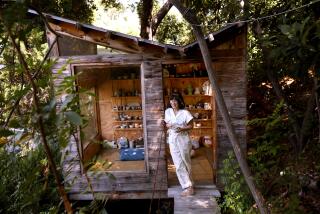The apex of the weaver’s art
- Share via
TAHOE CITY, Calif. — After her tribe’s traditional way of life was swallowed up by white settlers, the master Washoe weaver spent summers on Lake Tahoe ‘s shoreline making souvenir baskets for tourists and collectors that would one day be worth up to $1 million each.
Dat-so-la-lee also crafted small models of traditional baskets for her employer, Amy Cohn, who made her a star attraction at the Bicose curio shop at Tahoe City in the early 1900s.
Eighty years after Dat-so-la-lee’s death, an exhibit of 62 of those miniatures is on public display for the first time through Oct. 31 at the Gatekeeper’s Museum, just down the shore from where the curio shop once stood.
Though most measure no more than 5 inches, the works are as impressive as her large baskets, said Gene Quintana, the Carmichael, Calif., American Indian basketry collector and appraiser who owns the collection. The willow miniatures reflect the same craftsmanship that made Dat-so-la-lee one of the best-known basket weavers, he said.
“I think she’s the greatest American Indian basket maker by far,” Quintana said in a telephone interview. “When I walk into a museum, I can tell her baskets. They represent perfection in basketry.”
Even those unfamiliar with Indian basketry will come away from the exhibit with an appreciation for Dat-so-la-lee’s artistry, said Sue Ann Monteleone, registrar at the Nevada State Museum in Carson City. “She was one of the greatest weavers in the world of all time,” she said.
Dat-so-la-lee began weaving traditional baskets as a child, about 1850. Like other American Indian women, she switched to making baskets for tourists and collectors after her tribe’s way of life was disrupted by whites.
Blessed with huge, nimble hands, she earned international acclaim for the minute care with which she created spiraling surfaces of interlocking stitches. She was successfully marketed by Cohn, who promoted her as the “Indian Princess” Dat-so-la-lee and spun tales about her to command higher prices. Her real name was Louisa Keyser.
“Woven Legacy: A Collection of Dat-so-la-lee Works, 1900-1921” includes the only known fish trap and beaded basket made by Dat-so-la-lee, as well as “The Miniatures Among Miniatures” -- cup-shaped baskets so tiny they require a magnifying glass to fully appreciate.
Those baskets -- each less than half the size of a dime -- are showstoppers, said Sara Larson, museum director. They are “a demonstration of her skill,” Larson said. “It’s so difficult to strip the willow down to a thread that fine. And to be able to weave something with it is amazing.”
Quintana’s personal favorites are two flawless “degikups,” a form of basketry that Dat-so-la-lee introduced featuring a handsome spherical shape and smaller mouth. “Those two baskets really stand out to me,” Quintana said. “The shape and weaving is so nice and tight, and the design is well executed. Other basket makers have too much design. Her design is not crowded.”
The baskets are typical of Dat-so-la-lee works that tourists and collectors purchased for $2 to $6 during the weaver’s lifetime. Such works now fetch from $7,000 to $25,000, Quintana said. Some of her larger baskets now are worth up to $1 million, making hers the priciest of any American Indian works, Quintana said. One of her baskets sold for $750,000 in 2001.
Dat-so-la-lee wove more than 125 baskets for the Cohns from 1895 until her death in 1925 -- and an undetermined number of others before that.
“Some of her baskets got tossed out in the trash because people didn’t appreciate Native American art until 50 years later,” Quintana said.
The Nevada State Museum and Nevada Historical Society in Reno own 27 of her baskets, by far the largest public collection.
More to Read
The biggest entertainment stories
Get our big stories about Hollywood, film, television, music, arts, culture and more right in your inbox as soon as they publish.
You may occasionally receive promotional content from the Los Angeles Times.









